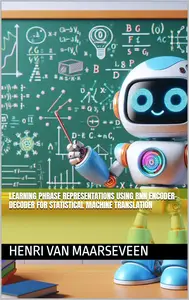- Témaindító
- #1
- Csatlakozás
- 2024.09.10.
- Üzenetek
- 25,854
- Reakció pontszám
- 8
- Díjak
- 5
- Kor
- 37

Free Download Learning Phrase Representations using RNN Encoder-Decoder for Statistical Machine Translation by Henri van Maarseveen
English | May 28, 2024 | ISBN: N/A | ASIN: B0D5GTBD8W | 102 pages | EPUB | 1.15 Mb
Overview of Machine Translation
Machine Translation (MT) refers to the automatic conversion of text from one language to another by a computer. The goal is to achieve translations that are as accurate and natural-sounding as possible. Over the years, various approaches have been developed to tackle the complexities of language, ranging from rule-based methods to more advanced statistical and neural techniques.
In the early days, MT relied heavily on hand-crafted rules and dictionaries. These rule-based systems, while pioneering, struggled with the vast variability and ambiguity inherent in human language. The advent of statistical methods marked a significant leap, allowing computers to learn from large corpora of bilingual text to produce more nuanced translations.
Traditional Statistical Methods
Statistical Machine Translation (SMT) emerged as a powerful paradigm in the 1990s. SMT systems use statistical models to translate text, relying on probability distributions derived from bilingual text corpora. The core idea is to break down the translation process into smaller, more manageable components, typically phrases, and then reassemble them into the target language. Key techniques in SMT include:
Phrase-Based Translation: Instead of translating word-by-word, phrases (groups of words) are translated to capture more context and produce more accurate translations.
Language Models: These models ensure that the generated translations are grammatically correct and fluent in the target language.
Alignment Models: These help in identifying which words or phrases in the source language correspond to those in the target language.
While SMT brought significant improvements over rule-based systems, it still faced several challenges. Translations often lacked fluency and accuracy, especially for longer sentences or languages with significant syntactic differences.
Impact on the Development of OpenAI's AI Software
The insights and techniques from Cho et al.'s paper have had a profound impact on the development of AI systems at OpenAI and beyond. By demonstrating the efficacy of neural networks in capturing complex language patterns, this research paved the way for more advanced models like the Transformer and GPT (Generative Pre-trained Transformer).
OpenAI's development of these models builds on the foundational concepts introduced in the paper, particularly the shift towards end-to-end learning and the use of continuous space representations. The success of the RNN Encoder-Decoder architecture inspired further innovations in sequence-to-sequence learning, ultimately leading to the sophisticated language models we see today.
Conclusion
Understanding the historical context and evolution of machine translation provides a solid foundation for appreciating the advancements introduced by Cho et al.'s 2014 paper. By addressing the limitations of traditional SMT with innovative neural techniques, this research has significantly influenced the trajectory of AI development, contributing to the creation of more powerful and versatile translation systems at OpenAI and other organizations. As we delve deeper into the technical details in subsequent chapters, this foundational knowledge will help readers grasp the significance and impact of these advancements.
Buy Premium From My Links To Get Resumable Support,Max Speed & Support Me
Code:
⚠
A kód megtekintéséhez jelentkezz be.
Please log in to view the code.
